From W. B. Tegetmeier 13 May 1872
The Field. | 346, Strand, | London, W.C.
May 13 1872
My dear Sir.
I am sure you will pardon my offences when fairly acknowledged
Some time since I asked you for the skull of the “Horned Cock” figured by you— I find that you returned it in a small tin box separate from the others and thus it was mislaid pray excuse my troubling you—1
I send you a photo shewing the bleaching action of the suns rays on “dun” feathers in pigeons— It was taken apropos of a discussion on the effect of light on Plumage. In which, knowing something about the subject practically, and my opponents only writing from supposition I came out victorious2
In your suggestion as to the possibility of breeding pigeons with different coloured sexes. Your supposition is strangely near the truth—3 “Silver” Dragons are often a sport from Blues—but they are almost always hens, and a silver hen and blue cock mated together will breed in the greatest number of instances a blue cock and silver hen in the same nest. Cocks are hard to procure, during the last two years I failed in procuring one and consequently bred 10 silver dragon hens but not one cock from, blue cocks and silver hens matched together
This year I have been fortunate in getting two silver cocks to breed from. they are both matched to silver hens, bred as before stated. The pair has had two nests. The first nest a blue cock and silver hen— the second a single blue bird two young to determine sex.— Second pair now breeding— There would be no difficulty in raising a breed in which all the cocks should be blue and the hens silver.— In fact the difficulty is not to do it—4
Dr Chapuis is quite right respecting the dark markings of cocks of the mealy or “pâle panaché” of the Belgian voyageurs—5
I send you two or three errata should you not have discovered them
You have been so kind as to send me a copy of all your later works, my edition of the Origin is the first (your gift)6 I want to read the last and I should indeed be pleased to have it like the others with your signature. forgive me if my request is impertinent but I am not often a beggar.—
I send you three notes that occurred to me as I read the volume;7, and should I put down any more I will send them.
You frequently quote E S Dixon I do not regard him as a reliable authority he is certainly wrong about the pairing of guinea fowls which you quote8
Believe me | very truly Yours | W B Tegetmeier
C Darwin Esq
[Enclosure 1]
Vol I Notes for Mr Darwin
page 19… A very strong athlete whom I described in the Field ( ) had the power of throwing the neck into deep fissures by the contraction of the platysma.
page 25. May not the fœtal lanugo be regarded as analogous with the temporary fœtal hair of certain mammals—that which is shed at birth. ex seal in which it is shed in enormous quantity.
page 39 Terror causes feathers on head of cowardly game cock or hen to be raised, a mark of cowardice recognised by cock fighters.9
[Enclosure 2]

CD annotations
Footnotes
Bibliography
Chapuis, Félicien. 1865. Le pigeon voyageur belge. Verviers: Imprimerie de Ch. Vinche.
Correspondence: The correspondence of Charles Darwin. Edited by Frederick Burkhardt et al. 29 vols to date. Cambridge: Cambridge University Press. 1985–.
Descent 2d ed.: The descent of man, and selection in relation to sex. By Charles Darwin. 2d edition. London: John Murray. 1874.
Descent: The descent of man, and selection in relation to sex. By Charles Darwin. 2 vols. London: John Murray. 1871.
Expression: The expression of the emotions in man and animals. By Charles Darwin. London: John Murray. 1872.
Origin: On the origin of species by means of natural selection, or the preservation of favoured races in the struggle for life. By Charles Darwin. London: John Murray. 1859.
Variation: The variation of animals and plants under domestication. By Charles Darwin. 2 vols. London: John Murray. 1868.
Summary
Has found the skull of the horned cock.
With regard to CD’s suggestion about the possibility of producing a pigeon breed with differently coloured sexes, WBT reports the results of crossing blue and silver dragons; the silver offspring are almost always hens.
Would like the latest edition of the Origin.
Encloses notes on volume one [of Descent].
Encloses a photograph showing the bleaching effect of the sun’s rays on dun feathers in pigeons.
Letter details
- Letter no.
- DCP-LETT-8322
- From
- William Bernhard Tegetmeier
- To
- Charles Robert Darwin
- Sent from
- The Field , London, Strand, 346
- Source of text
- DAR 88: 175–6, DAR 90: 101, DAR 178: 83, DAR 193: 22
- Physical description
- ALS 5pp †, encl Amem 1p † & photo
Please cite as
Darwin Correspondence Project, “Letter no. 8322,” accessed on 19 April 2024, https://www.darwinproject.ac.uk/letter/?docId=letters/DCP-LETT-8322.xml
Also published in The Correspondence of Charles Darwin, vol. 20


